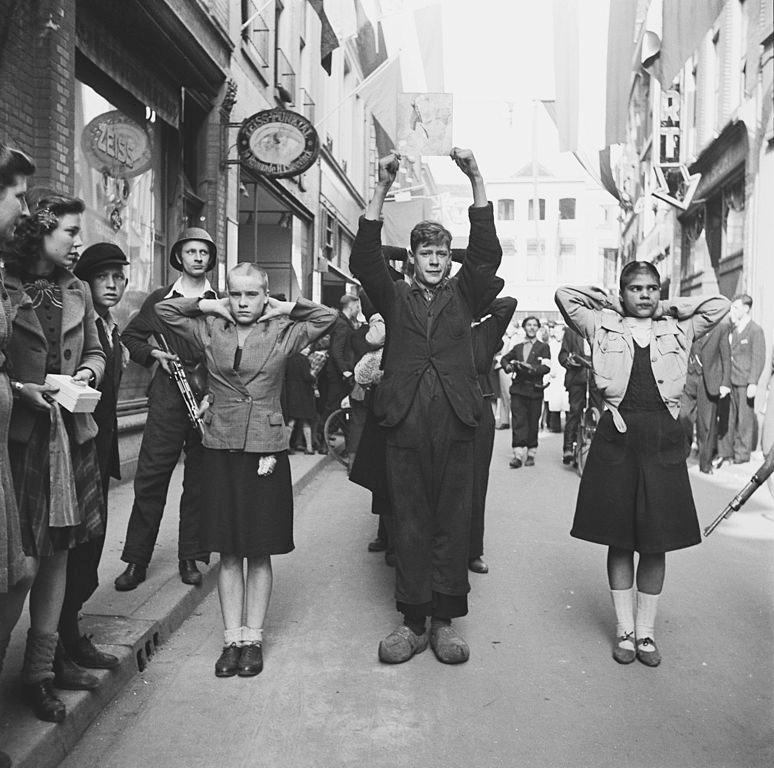
World War II: Dutch Collaboration--Retribution

Figure 1.--The caption read here, "Members of the NSB (Dutch national socialist party) and shaven 'kraut girls' are being brought in by members of the Dutch Resistance." The youths look too young for this. We suspect that their parents may have been NSB members and they had joined the Jeugdstorm. Notice the sign the boy is holding. We are not sure yet what the significance of that is. One reader tells us it seems to be a donkey--presumably making out to be an ass. Note that there are three adult men behind the teenager boy. The photograph was taken April 11. We were not at first sure where it was taken, but we believe somewhere in the eastern Netherlands north of the Rhine. A HBC reader has confirmed this. The town is Deventer. Click on the ijmage for a fuller discussion. Source: Dutch National Archive.
|
|
With liberation, the Dutch led by the Resistance, began rounding up collaborators. This began in the south first (September-November 1944). And began again as the Canadian began to liberate the north (April 1945). The targets included both Dutch Fascists and women who had been sleeping with the Germans. We also see youths who had joined the Fascist youth group (the Jeugdstorm) being rounded up. There was of course a huge difference. The women mostly were just trying to get on withtheir lives ahnd survive in the occupied Netherlands.
A Dutch reader writes, "The photograph of the Parisian collaborators reminds me of scenes I witnessed during the liberation of the Netherlands. Women who fraternized with the Germans--the moffenmeiden, They were despised by the Dutch who had to suffer through the occupation. Girls and women who had been seen with German soldiers were dragged from their homes and were made to stand on platforms where they were shaven bald. Then they had to stand in open trucks that slowly drove through the neigborhood under loud geering and twanting from the crowd. While on display they were insulted by the liberated population. I have seen it with my own eyes. It actually was awful and I am sure that many citizens regretted later what took place. But somehow it was understandable after 5 years of German occupation." [Stueck]
Collaborators were arrested and put in camps until they were sentenced to prison or sent home. That all depended on the seriousness of the collaboration. This was not always possible to dertermine. The Resistance did not get their hands on the thousands of Dutch volunteers who joined Waffen-SS formations which fought on the Eastern Front. They suffered grevious losses and many who survived the War perished in Soviet Gulag.
Sources
Stueck, Rudi. E-mail message, June 15, 2010.
CIH -- WW II

Navigate the CIH World War II Section:
[Return to Main Dutch World War II collaboration page]
[Return to Dutch World War II liberation]
[Return to Main Dutch World War II page]
[Return to Main World War II country page]
[Return to Main Dutch page]
[Biographies]
[Campaigns]
[Children]
[Countries]
[Deciding factors]
[Diplomacy]
[Geo-political crisis]
[Economics]
[Home front]
[Intelligence]
[POWs]
[Resistance]
[Race]
[Refugees]
[Technology]
[Bibliographies]
[Contributions]
[FAQs]
[Images]
[Links]
[Registration]
[Tools]
[Return to Main World War II page]
[Return to Main war essay page]
Created: 9:59 PM 6/9/2013
Last updated: 2:35 AM 6/11/2013



